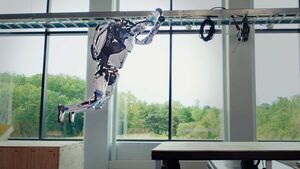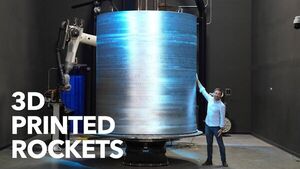2021-08-19 - Nº 329
Editorial
Esta é a Newsletter Nº 329 que se apresenta com o mesmo formato que as anteriores. Se gostar da Newsletter partilhe-a!
Todas as Newsletters encontram-se indexadas no link.
Esta Newsletter tem os seguintes tópicos:
Faz hoje anos que nascia, em 1580, o matemático francês Pierre Vernier. Ele inventou a escala Vernier, que permitiu aos instrumentos fazer medições lineares ou angulares mais precisas. Ele descreveu-a pela primeira vez numa obra intitulada La construction, l'usage et les propriétés du cadran nouveau (1631). Consiste numa pequena escala graduada ou arco feito para deslizar ao longo de uma escala fixa ou arco maior para permitir determinar o incremento entre duas graduações da escala maior. As dez divisões da escala menor, vernier, são iguais a nove da escala fixa. Por exemplo, os paquímetros com uma escala maior graduada em décimos de polegadas podem ser lidos através da utilização da escala de vernier até um centésimo de polegada. As escalas Vernier são também utilizadas em sextantes e barómetros de coluna de mercúrio.
Faz também hoje anos que nascia, em 1790, o relojoeiro e inventor inglês Edward John Dent. Ele era especialista em fabricar cronómetros com elevada precisão. As suas patentes neste campo incluíam bússolas para navegação e topografia. Fez experiências com molas feitas de aço, ouro e vidro, e dispositivos para contrariar os efeitos das mudanças de temperatura sobre os mecanismos do relógio. Como relojoeiro da Rainha Vitória, foi encarregado de construir o Grande Relógio para a torre do relógio das Câmaras do Parlamento (conhecido como Big Ben, embora esse seja de facto o apelido do seu sino horário) que começou no ano da sua morte. O seu filho, Frederick Dent, completou a obra no ano seguinte e foi instalado na torre em 1859. Continua a ser reconhecido pela sua grande precisão de 4 segundos num ano.
Faz igualmente hoje anos que nascia, em 1808, o engenheiro escocês James Nasmyth. Ele inventou o martelo pneumático que foi patenteado na Grã-Bretanha em 9 de Junho de 1842 (No. 9382). No início da sua carreira, Nasmyth melhorou a concepção das máquinas-ferramentas. Os martelos eléctricos tinham sido anteriormente movidos a vapor, mas Nasmyth concebeu o seu martelo a vapor com mais precisão e controlo. O vapor funcionava para levantar o martelo, que depois caía por gravidade, e repetia o ciclo. Nasmyth adaptou a ideia para fazer um bate-estacas a vapor. Com melhorias posteriores, o martelo a vapor permitiu forjar armas muito grandes para a marinha britânica.
Faz também hoje anos que nascia, em 1830, o químico alemão Lothar Meyer. Ele descobriu a Lei Periódica, independentemente de Dmitry Mendeleyev, aproximadamente na mesma altura (1869). No entanto, ele não desenvolveu a classificação periódica dos elementos químicos de forma tão completa como Mendeleyev. Meyer formou-se originalmente em medicina e química. Ele examinou o efeito do monóxido de carbono no sangue. Em 1879, Meyer comparou o volume atómico com o peso atómico. Traçado num gráfico, a curva mostrava a periodicidade dos elementos. Ele também estabeleceu o conceito de valência indicando que um dado elemento combinado com um número característico de átomos de hidrogénio, e cunhou os termos como univalente, bivalente, e trivalente, com base nesse número.
Faz igualmente hoje anos que nascia, em 1871, o inventor e aviador americano Orville Wright. Ele, com o seu irmão, Wilbur, inventou o primeiro avião motorizado, Flyer, capaz de um voo sustentado e controlado (17 Dez 1903). Em Kitty Hawk, na Carolina do Norte, Orville fez o primeiro voo tripulado com motor, que permaneceu no ar durante 12 segundos. Em 1905, tinham melhorado o design, construído e feito vários voos longos no Flyer III, que foi o primeiro avião totalmente prático (1905), capaz de voar até 38 minutos e viajar 24 milhas (39-km). O seu Modelo A foi produzido em 1908, capaz de voar durante mais de duas horas de voo. Venderam números consideráveis, mas os desenhadores europeus tornaram-se fortes concorrentes.
Faz também hoje anos que nascia, em 1883, o mineralogista russo Leonid Kulik. Ele conduziu a primeira expedição científica (cujos registos sobrevivem) para estudar o local de impacto do meteoro de Tungusta. Ele começou em 1927, e continuou a trabalhar na investigação até que, enquanto lutava pelo seu país na II Guerra Mundial, foi capturado e morreu de tifo num campo de prisioneiros nazi. O evento de Tungusta, numa região remota da Rússia, foi uma explosão que destruiu 2.200 km2 de floresta, que se acredita ter sido causada por um meteorito com mais de 50 m de diâmetro. Penetrou na atmosfera da Terra, aquecida a cerca de 10.000 ºC e detonou 6 a 10 km acima do solo, não deixando nenhuma cratera. A região era escassamente povoada, remota e difícil de alcançar, pelo que houve pouco interesse científico até quase 20 anos mais tarde, quando Kulik começou o seu trabalho.
Faz igualmente hoje anos que nascia, em 1906, o inventor americano Philo Farnsworth. Ele foi pioneiro no desenvolvimento da televisão electrónica, retirando todas as partes móveis das invenções televisivas. Farnsworth era um estudante de 15 anos do ensino secundário quando concebeu o seu primeiro sistema de televisão. Seis anos mais tarde, obteve a sua primeira patente. Em 1935, demonstrou o seu sistema de televisão completo. As patentes televisivas básicas de Farnsworth abrangiam a digitalização, focalização, sincronização, contraste, controlos e potência. Inventou também os primeiros tubos de raios catódicos frios e o primeiro microscópio electrónico simples. O fabrico da Philco TV recebeu o seu nome em homenagem a ele.
Faz também hoje anos que nascia, em 1923, o cientista da computação Edgar F. Codd. Ele, trabalhando na IBM, inventou o modelo relacional para a gestão de bases de dados, a base teórica para bases de dados relacionais e sistemas de gestão de bases de dados relacionais. Fez outras contribuições valiosas para a informática, mas o modelo relacional, uma teoria geral muito influente da gestão de dados, continua a ser o seu feito mais mencionado, analisado e celebrado.
Por fim, faz hoje anos que nascia, em 1939, o matemático britânico Alan Baker. Ele foi galardoado com a Medalha Fields em 1970. Atribuída a cada quatro anos por descobertas extraordinárias em matemática, a Medalha é considerada a maior honra no campo e o equivalente ao Prémio Nobel. Este prémio foi pelo seu trabalho na Teoria do Número Transcendental. Desde a Antiguidade Grega, as pessoas tentavam "quadrar um círculo" (criar um quadrado com a mesma área que um círculo usando apenas uma régua e bússolas), mas provou ser impossível no século passado ao mostrar que pi é um número transcendental (um número que não é uma solução de uma equação polinomial com coeficientes inteiros). O trabalho de Baker aqui foi um avanço com equações de diophantine. Baker também fez contribuições substanciais para o sétimo problema de Hilbert.
Em 1960, o Sputnik 5 foi lançado na órbita da Terra, levando dois cães chamados Belka (Esquilo) e Strelka (Flecha Pequena), juntamente com 40 ratos, 2 ratos e uma variedade de plantas, iniciando uma viagem segura de ida e volta ao Espaço, após o que se tornam os primeiros organismos vivos a regressar ao espaço. Após um dia em órbita, o foguetão da nave espacial foi activado e a cápsula de aterragem regressou à Terra a 20 de Agosto.
Nesta semana que passou, foi lançada a nova versão da distribuição Debian. Após 2 anos, 1 mês e 9 dias de desenvolvimento, o projecto Debian orgulha-se de apresentar a sua nova versão estável 11 (nome de código bullseye). Esta versão é disponibilizada com várias aplicações e ambientes de trabalho, entre os quais, o Gnome 3.38, o KDE Plasma 5.20, o LXDE 11, o LXQt 0,16, o MATE 1.24, e o Xfce 4.16. Este lançamento contém mais de 11.294 novos pacotes num total de 59.551 pacotes, juntamente com uma redução significativa de mais de 9.519 pacotes que foram marcados como obsoletos e removidos. 42.821 pacotes foram actualizados e 5.434 pacotes permaneceram inalterados. O Debian 11 bullseye inclui numerosos pacotes de software actualizados (mais de 72% de todos os pacotes da versão anterior), como por exemplo: Apache 2.4.48, Servidor DNS BIND 9.16, Calligra 3.2, Cryptsetup 2.3, Emacs 27.1, GIMP 2.10.22, Colecção de Compiladores GNU 10.2, GnuPG 2.2.20, Inkscape 1.0.2, LibreOffice 7.0, Kernel Linux série 5.10, MariaDB 10.5, OpenSSH 8.4p1, Perl 5.32, PHP 7.4, PostgreSQL 13, Python 3.9.1, Rustc 1.48, Samba 4.13 e Vim 8.2.
Na Newsletter desta semana apresentamos diversas noticias, artigos científicos, projetos de maker assim como alguns videos interessantes. É apresentada a revista Hackspace Magazine nº 46 de Setembro e o livro "Learning Go".
 João Alves ([email protected])
João Alves ([email protected])
O conteúdo da Newsletter encontra-se sob a licença  Creative Commons Attribution-NonCommercial-ShareAlike 4.0 International License.
Creative Commons Attribution-NonCommercial-ShareAlike 4.0 International License.
Novidades da Semana

Debian 11 bullseye released
"After 2 years, 1 month, and 9 days of development, the Debian project is proud to present its new stable version 11 (code name bullseye), which will be supported for the next 5 years thanks to the combined work of the Debian Security team and the Debian Long Term Support team. Debian 11 bullseye ships with several desktop applications and environments. Amongst others it now includes the desktop environments: - Gnome 3.38, - KDE Plasma 5.20, - LXDE 11, - LXQt 0.16, - MATE 1.24, - Xfce 4.16. This release contains over 11,294 new packages for a total count of 59,551 packages, along with a significant reduction of over 9,519 packages which were marked as obsolete and removed. 42,821 packages were updated and 5,434 packages remained unchanged. bullseye becomes our first release to provide a Linux kernel with support for the exFAT filesystem and defaults to using it for mount exFAT filesystems." [...]
Outras Notícias
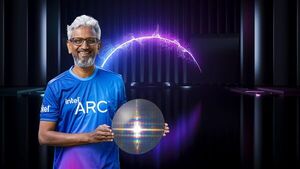
Intel Advances Architecture for Data Center, HPC-AI and Client Computing
"Architecture is alchemy of hardware and software. It blends the best transistors for a given engine, connects them through advanced packaging, integrates high-bandwidth, low-power caches, and equips them with high-capacity, high-bandwidth memories and low-latency scalable interconnects for hybrid computing clusters in a package, while also ensuring that all software accelerates seamlessly. Disclosing the architectural innovations that they have been working on for products that are imminent is something Intel’s architects look forward to each year at Intel Architecture Day, and this year’s event – our third – was the most exciting yet. Today, we unveiled our biggest shifts in Intel® architectures in a generation. This includes the first in-depth look at Alder Lake, our first performance hybrid architecture with two new generations of x86 cores and the intelligent Intel® Thread Director workload scheduler; Sapphire Rapids, Intel’s new standard-setting data center architecture with our new Performance-core and various accelerator engines; our new discrete gaming graphics processing unit (GPU) architecture; new infrastructure processing units (IPUs); and Ponte Vecchio, our tour-de-force data center GPU architecture with Intel’s highest ever compute density. These architectural breakthroughs set the stage for our next era of leadership products, starting soon with Alder Lake." [...]

New Chip Scale Atomic Clock (CSAC) Provides Wider Operating Temperatures, Faster Warm-up and Improved Frequency Stability in Extreme Environments
"Microchip’s SA65 CSAC for military and industrial systems features ultra-high precision and low power consumption Advanced military platforms, ocean-bottom survey systems and remote sensing applications all require precise timing for mission success. Chip Scale Atomic Clocks (CSACs) ensure stable and accurate timing even when Global Navigation Satellite Systems (GNSS) time signals are unavailable. Helping industrial and military system designers to meet this requirement, Microchip Technology Inc. (Nasdaq: MCHP) today announced its new SA65 CSAC, providing precise timing accuracy and stability in extreme environments. Microchip’s SA65 CSAC is an embedded timing solution with improved environmental ruggedness, delivering higher performance than the previous SA.45s CSAC, including double the frequency stability over a wider temperature range and faster warm-up at cold temperatures. The SA65 has an operating temperature range of -40 to 80 degrees Celsius (oC) and a storage temperature range of -55 to 105 oC. The warm-up time of two minutes at -40 oC is 33% faster than that of the SA.45s." [...]

Trinamic’s 3-Phase MOSFET Gate Driver Maximizes Battery Life and Cuts Component Count by Half
"Fully integrated TMC6140-LA simplifies design of high-performance brushless DC motor drives and improves efficiency by 30 percent Hamburg, Germany–August 16, 2021–TRINAMIC Motion Control GmbH & Co. KG, now part of Maxim Integrated Products, Inc. (NASDAQ: MXIM), introduces the fully integrated TMC6140-LA 3-phase MOSFET gate driver that simplifies design and maximizes battery life of brushless direct current (DC) motor drives. The TMC6140-LA 3-phase MOSFET gate driver integrates all three bottom shunt amplifiers to provide a complete motor drive solution with 30-percent improved power efficiency, while simplifying design by reducing component count by half when compared to similar solutions. The TMC6140-LA is optimized for performance over a wide voltage range, making it well-suited for servo motors, brushless motors and permanent magnet synchronous motors. The three-phase gate driver is equipped with pins to add a charge pump, statically stabilizing the gate voltages of external MOSFETs in three-phase motors with up to 100A of coil current. Offered in a 36-pin quad-flat no-leads (QFN) package, the gate driver is a flexible solution offering 0.5A or 1.0A gate driver current for 5V to 30V DC battery-powered applications, such as power tools where voltages can drop below 10V. Integrated current sense and diagnostics features add functional safety while simplifying design." [...]

NASA’s Curiosity Mars Rover Explores a Changing Landscape
"A new video rings in the rover’s ninth year on Mars, letting viewers tour Curiosity’s location on a Martian mountain. Images of knobbly rocks and rounded hills are delighting scientists as NASA’s Curiosity rover climbs Mount Sharp, a 5-mile-tall (8-kilometer-tall) mountain within the 96-mile-wide (154-kilometer-wide) basin of Mars’ Gale Crater. The rover’s Mast Camera, or Mastcam, highlights those features in a panorama captured on July 3, 2021 (the 3,167th Martian day, or sol, of the mission). This location is particularly exciting: Spacecraft orbiting Mars show that Curiosity is now somewhere between a region enriched with clay minerals and one dominated by salty minerals called sulfates. The mountain’s layers in this area may reveal how the ancient environment within Gale Crater dried up over time. Similar changes are seen across the planet, and studying this region up close has been a major long-term goal for the mission." [...]
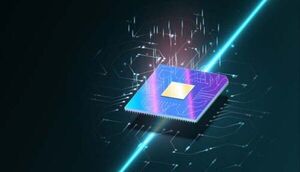
Rambus Advances AI/ML Performance with 8.4 Gbps HBM3-Ready Memory Subsystem
"Rambus Inc. (NASDAQ: RMBS), a premier chip and silicon IP provider making data faster and safer, today announced the Rambus HBM3-ready memory interface subsystem consisting of a fully-integrated PHY and digital controller. Supporting breakthrough data rates of up to 8.4 Gbps, the solution can deliver over a terabyte per second of bandwidth, more than double that of high-end HBM2E memory subsystems. With a market-leading position in HBM2/2E memory interface deployments, Rambus is ideally suited to enable customers’ implementations of accelerators using next-generation HBM3 memory. “The memory bandwidth requirements of AI/ML training are insatiable with leading-edge training models now surpassing billions of parameters,” said Soo Kyoum Kim, associate vice president, Memory Semiconductors at IDC. “The Rambus HBM3-ready memory subsystem raises the bar for performance enabling state-of-the-art AI/ML and HPC applications.” Rambus achieves HBM3 operation of up to 8.4 Gbps leveraging over 30 years of high-speed signaling expertise, and a strong history of 2.5D memory system architecture design and enablement. In addition to the fully-integrated HBM3-ready memory subsystem, Rambus provides its customers with interposer and package reference designs to speed their products to market." [...]

Apricot subsea cable will boost internet capacity, speeds in the Asia-Pacific region
"We are excited to announce our participation in the Apricot subsea cable system, together with leading regional and global partners. When completed, the project (which is still subject to regulatory approvals) will deliver much-needed internet capacity, redundancy, and reliability to expand connections in the Asia-Pacific region. The 12,000-kilometer-long cable will connect Japan, Taiwan, Guam, the Philippines, Indonesia and Singapore. Apricot will feature a state of the art configuration allowing flexibility in trunk and branch capacity. Expected to launch in 2024, the Apricot cable system will have an initial design capacity of more than 190 terabits per second to meet rising data demands in the region and support existing cable systems, such as the recently announced Echo and Bifrost cable systems. The cable will help meet the growing demand for 4G, 5G, and broadband access in the region." [...]
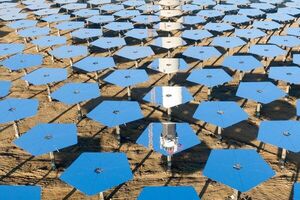
China aims to use space-based solar energy station to harvest sun’s rays to help meet power needs
"With more than a third of days marred by fog all year round, Chongqing city in southwestern China is not the ideal place for a solar power plant. But soon it will have the nation’s first experimental facility to test a revolutionary technology allowing China to send, and receive, a powerful energy beam from space in about a decade, according to scientists involved in the project. Harvesting energy from the sun and beaming it to Earth using huge infrastructure in orbit has been regarded as science fiction, but according to a plan by the Chinese government, the nation will put a 1 megawatt solar energy station in space by 2030. And by 2049, when the People’s Republic of China celebrates its 100th anniversary, the total power capacity of the plant or plants would increase to 1 gigawatt, the equivalent of the current largest nuclear power reactor. After breaking ground in Heping village, Bishan district, three years ago, construction of the 100-million-yuan (US$15.4 million) ground testing facility for the national space solar-power programme stopped, in part because of debates about cost, feasibility and safety of the technology. The project resumed in June, according to the district government’s website." [...]
Ciência e Tecnologia

Magnets could offer better control of prosthetic limbs
"System uses tiny magnetic beads to rapidly measure the position of muscles and relay that information to a bionic prosthesis. For people with amputation who have prosthetic limbs, one of the greatest challenges is controlling the prosthesis so that it moves the same way a natural limb would. Most prosthetic limbs are controlled using electromyography, a way of recording electrical activity from the muscles, but this approach provides only limited control of the prosthesis. Researchers at MIT’s Media Lab have now developed an alternative approach that they believe could offer much more precise control of prosthetic limbs. After inserting small magnetic beads into muscle tissue within the amputated residuum, they can precisely measure the length of a muscle as it contracts, and this feedback can be relayed to a bionic prosthesis within milliseconds. In a new study appearing today in Science Robotics, the researchers tested their new strategy, called magnetomicrometry (MM), and showed that it can provide fast and accurate muscle measurements in animals." [...]

High-speed camera captures a water jet’s splashy impact as it pierces a droplet
"The results may help engineers develop a way to inject drugs without needles. Squirting a jet of water through a drop of liquid may sound like idle fun, but if done precisely, and understood thoroughly, the splashy exercise could help scientists identify ways to inject fluids such as vaccines through skin without using needles. That’s the motivation behind a new study by engineers at MIT and the University of Twente in the Netherlands. The study involves firing small jets of water through many kinds of droplets, hundreds of times over, using high-speed cameras to capture each watery impact. The team’s videos are reminiscent of the famous strobe-light photographs of a bullet piercing an apple, pioneered by MIT’s Harold “Doc” Edgerton. Edgerton’s images captured sequential images of a bullet being shot through an apple, in explosive detail." [...]

Fusion Progress Validates A 40-Year Quest
"A 10-quadrillion-watt burst at Lawrence Livermore is good news for LLE as well When researchers at Lawrence Livermore National Laboratory this week announced they had ignited a burst of more than 10 quadrillion watts of fusion power, it was cause for celebration at the University of Rochester’s Laboratory for Laser Energetics as well. The announcement validates the laser-driven implosion techniques that the two labs have closely collaborated on, as a way to assess the viability of the nation’s nuclear weapons stockpile and perhaps even pave the way for an abundant supply of clean energy. Even skeptics were impressed by the results of the August 8 experiment. In a story in the New York Times, for example, Stephen Bodner, a retired plasma physicist who has long been a critic of Lawrence Livermore’s National Ignition Facility (NIF), expressed surprise, adding, “they have come close enough to their goal of ignition and break-even to call it a success.” Says Riccardo Betti, LLE’s chief scientist and a leading expert in the field, “This really clears up a lot of the concern about the ability to ignite thermonuclear fuel in the lab, or that we would need much bigger lasers to do it. This is a major step forward.” Since the early 1970s, scientists have pursued the possibility of using high-power lasers to compress thermonuclear material long enough, at high enough temperatures to trigger ignition — resulting in an output of fusion energy many times greater than the energy required for ignition. The entire process of compression and ignition, which occurs in nanoseconds, is called inertial confinement fusion (ICF)." [...]

Record-breaking lithium metal battery
"Nickel-rich cathode and ionic liquid electrolyte enable extremely high energy density with good stability - researchers report in Joule magazine A new type of lithium metal battery offers an extremely high energy density of 560 watt hours per kilogram with remarkably good stability. For this purpose, researchers at the Helmholtz Institute Ulm (HIU), founded by the Karlsruhe Institute of Technology (KIT) in cooperation with the University of Ulm, have used a promising combination of cathode and electrolyte: the nickel-rich cathode allows a lot of energy per mass to be stored, the ionic liquid electrolyte ensures that the capacity is largely retained over many charging cycles. The team reports on the record-breaking lithium metal battery in the magazine Joule (DOI: 10.1016 / j.joule.2021.06.014 ) Lithium-ion batteries are currently the most common solution for mobile power supply. However, the technology reaches its limits when it comes to certain requirements. This is especially true for electromobility, where light, compact vehicles with long ranges are in demand. Lithium metal batteries are an alternative: They are characterized by a high energy density, which means that they store a lot of energy per mass or volume." [...]

Inflatable robotic hand gives amputees real-time tactile control
"Prosthetic enables a wide range of daily activities, such as zipping a suitcase, shaking hands, and petting a cat. For the more than 5 million people in the world who have undergone an upper-limb amputation, prosthetics have come a long way. Beyond traditional mannequin-like appendages, there is a growing number of commercial neuroprosthetics — highly articulated bionic limbs, engineered to sense a user’s residual muscle signals and robotically mimic their intended motions. But this high-tech dexterity comes at a price. Neuroprosthetics can cost tens of thousands of dollars and are built around metal skeletons, with electrical motors that can be heavy and rigid. Now engineers at MIT and Shanghai Jiao Tong University have designed a soft, lightweight, and potentially low-cost neuroprosthetic hand." [...]

Common Solar Tech Can Power Smart Devices Indoors, NIST Study Finds
"Any time you turn on a light at home or in the office, you are expending energy. But what if flipping the light switch meant producing energy too? We usually think of solar, or photovoltaic (PV), cells fixed to roofs, converting sunlight into electricity, but bringing that technology indoors could further boost the energy efficiency of buildings and energize swaths of wireless smart technologies such as smoke alarms, cameras and temperature sensors, also called Internet of Things (IoT) devices. Now, a study from the National Institute of Standards and Technology (NIST) suggests that a straightforward approach for capturing light indoors may be within reach. NIST researchers tested the indoor charging ability of small modular PV devices made of different materials and then hooked up the lowest efficiency module — composed of silicon — to a wireless temperature sensor. The team’s results, published in the journal Energy Science & Engineering, demonstrate that the silicon module, absorbing only light from an LED, supplied more power than the sensor consumed in operation." [...]

Minding the gaps to boost perovskite performance
"A simple holistic solution plugs the performance-sapping defects that hamper new alternative solar materials. A multifunctional molecule that plugs various atomic-scale defects in perovskite solar materials can significantly boost the longevity and electrical output of this promising solar technology, KAUST researchers have shown. Perovskites are an alternative solar-cell material to silicon. They typically comprise a combination of negatively charged iodine or bromine ions and positively charged lead and organic ions. Adjusting the ion combination can generate wide bandgap perovskites that capture the solar wavelengths that silicon does not efficiently absorb. This suggests the two materials could be combined in tandem cells to capture even more energy from the Sun." [...]

New clean energy tech extracts twice the power from ocean waves
"Researchers have developed prototype technology that can double the power harvested from ocean waves, in an advance that could finally make wave energy a viable renewable alternative. The untapped potential of ocean wave energy is vast - it has been estimated that the power of coastal waves around the world each year is equivalent to annual global electricity production. With over 35,000 km of coastline, Australia is ideally placed to tap into this power source. Analysis shows Australia could produce twice its current electricity output by harvesting just 17% of its wave energy. But the challenges of developing technologies that can efficiently extract that natural power and withstand the harsh ocean environment have kept wave energy stuck at experimental stage. Now a research team led by RMIT University has created a wave energy converter that is twice as efficient at harvesting power as any similar technologies developed to date." [...]

Smart laser cutter system detects different materials
"“SensiCut,” a smart material-sensing platform for laser cutters, can differentiate between 30 materials commonly found in makerspaces and workshops. With the addition of computers, laser cutters have rapidly become a relatively simple and powerful tool, with software controlling shiny machinery that can chop metals, woods, papers, and plastics. While this curious amalgam of materials feels encompassing, users still face difficulties distinguishing between stockpiles of visually similar materials, where the wrong stuff can make gooey messes, give off horrendous odors, or worse, spew out harmful chemicals. Addressing what might not be totally apparent to the naked eye, scientists from MIT’s Computer Science and Artificial Intelligence Laboratory (CSAIL) came up with “SensiCut,” a smart material-sensing platform for laser cutters. In contrast to conventional, camera-based approaches that can easily misidentify materials, SensiCut uses a more nuanced fusion. It identifies materials using deep learning and an optical method called “speckle sensing,” a technique that uses a laser to sense a surface’s microstructure, enabled by just one image-sensing add-on." [...]
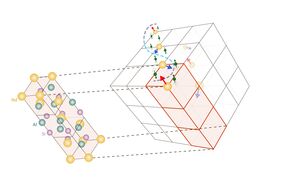
Scientists Discover Crystal Exhibiting Exotic Spiral Magnetism
"An exotic form of magnetism has been discovered and linked to an equally exotic type of electrons, according to scientists who analyzed a new crystal in which they appear at the National Institute of Standards and Technology (NIST). The magnetism is created and protected by the crystal’s unique electronic structure, offering a mechanism that might be exploited for fast, robust information storage devices. The newly invented material has an unusual structure that conducts electricity but makes the flowing electrons behave as massless particles, whose magnetism is linked to the direction of their motion. In other materials, such Weyl electrons have elicited new behaviors related to electrical conductivity. In this case, however, the electrons promote the spontaneous formation of a magnetic spiral. “Our research shows a rare example of these particles driving collective magnetism,” said Collin Broholm, a physicist at Johns Hopkins University who led the experimental work at the NIST Center for Neutron Research (NCNR)." [...]
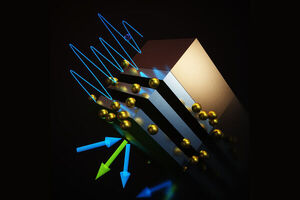
A peculiar state of matter in layers of semiconductors
"In a study that could benefit quantum computing, researchers show a superlattice embedded with nanodots may be immune from dissipating energy to the environment. Scientists around the world are developing new hardware for quantum computers, a new type of device that could accelerate drug design, financial modeling, and weather prediction. These computers rely on qubits, bits of matter that can represent some combination of 1 and 0 simultaneously. The problem is that qubits are fickle, degrading into regular bits when interactions with surrounding matter interfere. But new research at MIT suggests a way to protect their states, using a phenomenon called many-body localization (MBL). MBL is a peculiar phase of matter, proposed decades ago, that is unlike solid or liquid." [...]

Earth’s core may contain up to 95% of planet’s carbon
"Rice, Florida State study improves understanding of habitable rocky planets New research from Rice University and Florida State University suggests Earth’s core contains up to 95% of the planet’s carbon. The study, published online this week in the journal Communications Earth & Environment, estimates Earth’s outer core is 0.3% to 2% carbon. Though the percentage is low, the outer core’s immense size puts the estimated weight of carbon between 6 million trillion tons and 41 million trillion tons. “Understanding the composition of the Earth’s core is one of the key problems in the solid-earth sciences,” said co-author Mainak Mookherjee, an associate professor of geology in Florida State’s Department of Earth, Ocean and Atmospheric Science. “We know the planet’s core is largely iron, but the density of iron is greater than that of the core. There must be lighter elements in the core that reduce its density." [...]

ITMO Students Develop New Manipulator Arm That Can Be Applied Everywhere: From Catering to Chemistry Labs
"ITMO University students developed a compact manipulator arm using polymers, which helped significantly bring down its production costs. At the same time, the new device is just as secure and precise as its existing analogs. The project is headed by Islam Bzhikhatlov, a PhD student at ITMO University, who told ITMO.NEWS about the robot’s potential applications, the tasks it can solve, and the way it stands out from similar products. How long have you been working on the project? It was a practice-oriented R&D project that engaged Bachelor’s and Master’s students in robotics for a little over a year. In April 2020, we launched the development and this June the team completed the robot’s testing." [...]
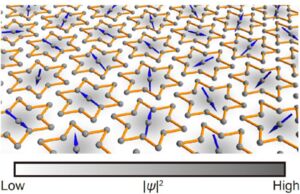
This Exotic Particle Had an Out-of-Body Experience; These Scientists Took a Picture of It
"An unexpected finding by scientists at Berkeley Lab and UC Berkeley could advance quantum computers and high-temperature superconductors Scientists have taken the clearest picture yet of electronic particles that make up a mysterious magnetic state called a quantum spin liquid (QSL). The achievement could facilitate the development of superfast quantum computers and energy-efficient superconductors. The scientists are the first to capture an image of how electrons in a QSL decompose into spin-like particles called spinons and charge-like particles called chargons. “Other studies have seen various footprints of this phenomenon, but we have an actual picture of the state in which the spinon lives. This is something new,” said study leader Mike Crommie, a senior faculty scientist at Lawrence Berkeley National Laboratory (Berkeley Lab) and physics professor at UC. “Spinons are like ghost particles." [...]

Supersolid in a new dimension
"Quantum matter can be solid and fluid at the same time – a situation known as supersolidity. Researchers led by Francesca Ferlaino have now created for the first time this fascinating property along two dimensions. They now report in the journal Nature on the realization of supersolidity along two axes of an ultracold quantum gas. Quantum gases are very well suited for investigating the microscopic consequences of interactions in matter. Today, scientists can precisely control individual particles in extremely cooled gas clouds in the laboratory, revealing phenomena that cannot be observed in the every-day world. For example, the individual atoms in a Bose-Einstein condensate are completely delocalized." [...]
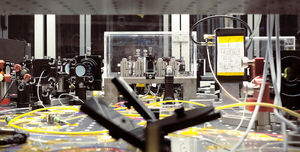
DTU researchers tighten grip on quantum computer
"In a new groundbreaking work, researchers from DTU have now realized the complete platform for an optical quantum computer. The platform is universal and scalable, it all takes place at room temperature, and the technology is directly compatible with standard fibre optic networks. This puts DTU right at the forefront of the development. Optical quantum computers have long been overshadowed by superconducting technologies that have been accelerated by huge development programmes run at tech giants like IBM and Google. The situation is now changing, one reason being a string of pioneering projects performed by researchers at the basic research centre bigQ at DTU Physics. In fact, the researchers at DTU are not limiting themselves to simply developing individual components for an optical quantum computer or just a quantum simulator." [...]

Polymer enables tougher recyclable thermoplastics
"To synthesize plastic, small monomer molecules need to be strung together like beads in a necklace, creating long polymer chains. However, not all plastics – or their polymers – are created equal. The longer and stronger the polymer, the more durable the material. Cornell researchers took a middling monomer and, by using a special catalyst, they created a tougher polymer that can form long chains. The polymer can then be easily depolymerized back to the monomer state with an acid catalyst, resulting in a chemically recyclable thermoplastic that competes with the most popular plastics, polyethylene and polypropylene. The team’s paper, “Chemically Recyclable Thermoplastics from Reversible-Deactivation Polymerization of Cyclic Acetals,” published Aug. 13 in Science." [...]
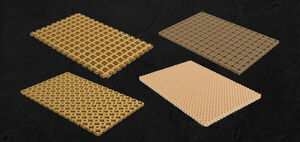
New Algorithm Can Help Improve Cellular Materials Design
"New research published in Scientific Reports has revealed that a simple but robust algorithm can help engineers to improve the design of cellular materials that are used in a variety of diverse applications ranging from defence, bio-medical to smart structures and the aerospace sector. The way in which cellular materials will perform can be uncertain and so calculations to help engineers predict how they will react for a particular design, for a given set of loads, conditions and constraints, can help maximise their design and subsequent performance. The research collaborators at the Faculty of Science and Engineering, Swansea University, Indian Institute of Technology Delhi and Brown University, USA, found that running specialised calculations can help engineers to find the optimum micro-structure for cellular materials that are used for a wide range of purposes, from advanced aerospace applications to stents used for blocked arteries. Research author Dr Tanmoy Chatterjee said: “This paper is the result of one year of sustained collaborative research. The results illustrate that uncertainties in the micro-scale can drastically impact the mechanical performance of metamaterials. Our formulation achieved novel microstructure designs by employing computational algorithms which follow the evolutionary principles of nature.” Co-author Professor Sondipon Adhikari explains: “This approach allowed us to achieve extreme mechanical properties involving negative Poisson’s ratio (auxetic metamaterial) and elastic modulus." [...]

Black hole size revealed by its eating pattern
"The feeding patterns of black holes offer insight into their size, researchers report. A new study revealed that the flickering in the brightness observed in actively feeding supermassive black holes is related to their mass. Supermassive black holes are millions to billions of times more massive than the sun and usually reside at the center of massive galaxies. When dormant and not feeding on the gas and stars surrounding them, SMBHs emit very little light; the only way astronomers can detect them is through their gravitational influences on stars and gas in their vicinity. However, in the early universe, when SMBHs were rapidly growing, they were actively feeding – or accreting – materials at intensive rates and emitting an enormous amount of radiation – sometimes outshining the entire galaxy in which they reside, the researchers said. The new study, led by the University of Illinois Urbana-Champaign astronomy graduate student Colin Burke and professor Yue Shen, uncovered a definitive relationship between the mass of actively feeding SMBHs and the characteristic timescale in the light-flickering pattern." [...]
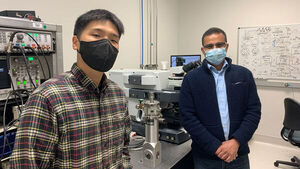
Researchers demonstrate new semiconductor device possibilities using black phosphorus
"Stress and strain, applied in just the right manner, can sometimes produce amazing results. That is what researchers, led by a team at UC Berkeley’s Department of Electrical Engineering and Computer Sciences, discovered about an emerging semiconductor material — black phosphorus (BP) — used to make two types of optoelectronic devices: light emitting diodes (LEDs) and photodetectors. Under mechanical strain, BP can be induced to emit or detect infrared (IR) light in a range of desirable wavelengths — 2.3 to 5.5 micrometers, which spans the short- to mid-wave IR — and to do so reversibly at room temperature, according to study authors Ali Javey, Lam Research Distinguished Chair in Semiconductor Processing and professor of electrical engineering, and postdoctoral fellow Hyungjin Kim. Javey is also a faculty senior scientist at the Lawrence Berkeley National Laboratory. Their findings are significant not only for the ability to reach these wavelengths, Javey and Kim said, but to do so tunably and in one device. Current technology would require multiple bulky devices and differing semiconductor materials to achieve similar results." [...]
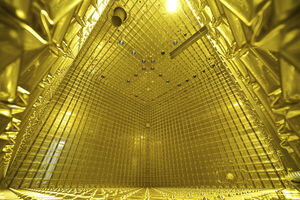
CERN to provide second DUNE cryostat
"The Laboratory deepens its collaboration with the US-based neutrino experiment with the provision of two enormous stainless-steel vessels for DUNE’s cutting-edge liquid-argon detectors Neutrinos are tricky beasts. Alone among known fundamental particles, they suffer from an identity crisis – if it were possible to put them on a weighing scale, you would unpredictably measure one of three possible masses. As a result, the three neutrino “flavours” merge into each other as they race through space and matter, opening up the potential for matter–antimatter asymmetries relevant to open questions in cosmology. Neutrinos are today the subject of a vibrant worldwide research programme in particle physics, astrophysics and multi-messenger astronomy. In an eye-catching example of international collaboration in particle physics, CERN has now agreed to produce a second cryostat for the detectors of the international Deep Underground Neutrino Experiment (DUNE) in the US. Cryostats are huge stainless-steel vessels that will eventually hold and cool 70 000 tonnes of liquid argon inside the DUNE experiment’s detectors." [...]

Researchers Develop Turing Membrane to Improve Performance of Zinc-based Batteries
"Zinc-based batteries are promising options for energy storage devices owing to their low cost and high energy density. However, they may encounter serious dendrite issues, especially at high areal capacities and current densities. Recently, a research team led by Prof. LI Xianfeng from the Dalian Institute of Chemical Physics (DICP) of the Chinese Academy of Sciences developed novel membranes for zinc-based batteries, achieving uniform zinc deposition with high areal capacity and current density. This work was published in Journal of the American Chemical Society on July 27. "We proposed a novel membrane featuring ordered undulating stripes called Turing Patterns, which can effectively suppress zinc dendrites and improve ion conductivity," said Prof. LI. The crests and troughs in the proposed membrane could effectively adjust the Zn(OH)42- distribution and provide more zinc deposition space." [...]

Wearable technology research at Stanford
"From developing innovative means of production to testing the quality of commercially available products, Stanford researchers are enthusiastically involved in improving wearable technologies. As technology continues to get smaller and smarter, the world of wearable technologies grows larger. Many people already own devices that can monitor their movement, heartbeat and sleep – but what about a watch that can tell when you’re sick or an exoskeleton that can predict and prevent falls? Such inventions may be in our future if current Stanford University research is any indication. In order to get the most out of future wearables, researchers are studying all stages of their design, production and use. This includes not only making new kinds of wearable devices but also innovating how they are fabricated and making sure existing wearables live up to their exciting promises." [...]

Cracking a Mystery of Massive Black Holes and Quasars with Supercomputer Simulations
"A discovery that provides new insight into how galaxies evolve At the center of galaxies, like our own Milky Way, lie massive black holes surrounded by spinning gas. Some shine brightly, with a continuous supply of fuel, while others go dormant for millions of years, only to reawaken with a serendipitous influx of gas. It remains largely a mystery how gas flows across the universe to feed these massive black holes. UConn Assistant Professor of Physics Daniel Anglés-Alcázar, lead author on a paper published today in The Astrophysical Journal, addresses some of the questions surrounding these massive and enigmatic features of the universe by using new, high-powered simulations. “Supermassive black holes play a key role in galaxy evolution and we are trying to understand how they grow at the centers of galaxies,” says Anglés-Alcázar. “This is very important not just because black holes are very interesting objects on their own, as sources of gravitational waves and all sorts of interesting stuff, but also because we need to understand what the central black holes are doing if we want to understand how galaxies evolve.” Anglés-Alcázar, who is also an Associate Research Scientist at the Flatiron Institute Center for Computational Astrophysics, says a challenge in answering these questions has been creating models powerful enough to account for the numerous forces and factors that play into the process." [...]

A new liquid crystal ink for 3D printing
"TU/e researchers have synthesized a liquid crystal ink to imitate structures in nature for possible applications in healthcare and lighting. Cholesteric liquid crystals, a man-made material with properties between liquids and solid crystals, can mimic the colors of butterfly wings. Liquid crystals are used in televisions and smartphones, but future applications for healthcare sensors or decorative lighting are difficult as the materials can’t be used in advanced, rapid production methods like 3D printing. The materials are not viscous enough to make stable, solid structures, and it’s difficult to align the molecules to produce specific colors. TU/e researchers have solved these issues by developing a new light-reflective liquid crystal ink that can be used with existing 3D printing techniques. The new research has been published in the journal Advanced Materials." [...]

The University of Applied Sciences of Graubünden knows Pi best - world record!
"The University of Applied Sciences of Graubünden knows Pi best - world record! By early Saturday morning it was clear: The world record calculation of the number Pi by the University of Applied Sciences Graubünden was successful, the record is back in Switzerland after two American record holders. The high-performance computer at the Center for Data Analytics, Visualization and Simulation (DAViS) has exceeded the old world record of 50 trillion jobs by an additional 12.8 trillion new, previously unknown jobs. The last ten known digits of Pi are now: 7817924264. The calculation of the new Pi-digit world record by the DAViS team of the University of Applied Sciences in Graubünden took 108 days and 9 hours. It is therefore almost twice as fast as the record that Google set in its cloud in 2019, and around 3.5 times as fast as the last world record from 2020." [...]
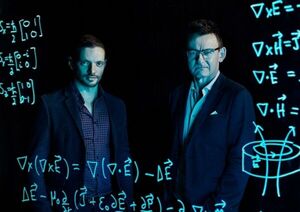
'Missing jigsaw piece': engineers make critical advance in quantum computer design
"A decades-old problem about how to reliably control millions of qubits in a silicon quantum computer chip has now been solved. Quantum engineers from UNSW Sydney have removed a major obstacle that has stood in the way of quantum computers becoming a reality: they discovered a new technique they say will be capable of controlling millions of spin qubits – the basic units of information in a silicon quantum processor. Until now, quantum computer engineers and scientists have worked with a proof-of-concept model of quantum processors by demonstrating the control of only a handful of qubits. But with their latest research, published today in Science Advances, the team have found what they consider ‘the missing jigsaw piece’ in the quantum computer architecture that should enable the control of the millions of qubits needed for extraordinarily complex calculations. Dr Jarryd Pla, a faculty member in UNSW’s School of Electrical Engineering and Telecommunications says his research team wanted to crack the problem that had stumped quantum computer scientists for decades: how to control not just a few, but millions of qubits without taking up valuable space with more wiring, using more electricity, and generating more heat. “Up until this point, controlling electron spin qubits relied on us delivering microwave magnetic fields by putting a current through a wire right beside the qubit,” Dr Pla says." [...]
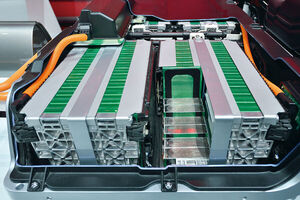
Designing better batteries for electric vehicles
"As researchers consider materials for solid-state batteries, they also may want to consider how those materials could impact large-scale manufacturing. The urgent need to cut carbon emissions is prompting a rapid move toward electrified mobility and expanded deployment of solar and wind on the electric grid. If those trends escalate as expected, the need for better methods of storing electrical energy will intensify. “We need all the strategies we can get to address the threat of climate change,” says Elsa Olivetti PhD ’07, the Esther and Harold E. Edgerton Associate Professor in Materials Science and Engineering. “Obviously, developing technologies for grid-based storage at a large scale is critical. But for mobile applications — in particular, transportation — much research is focusing on adapting today’s lithium-ion battery to make versions that are safer, smaller, and can store more energy for their size and weight.” Traditional lithium-ion batteries continue to improve, but they have limitations that persist, in part because of their structure." [...]

To Reduce Vehicle Pollution, a Single Atom Can Do the Work of Several
"Researchers hit on a way to reduce precious metals in engine aftertreatment systems Your ride might be a modest one—but if it burns gasoline, you have precious metals on board. To reduce pollution at the tailpipe, gasoline cars and trucks today come equipped with catalytic converters that contain platinum-group metals such as rhodium and palladium. Demand for these metals is mounting as countries around the world seek to lower vehicle emissions that accelerate climate change and worsen air quality. Given that a single ounce of rhodium now costs more than $20,000, it's no coincidence that across the United States, thefts of catalytic converters are on the rise. A discovery by scientists from Pacific Northwest National Laboratory (PNNL) and Washington State University could help reduce the amount of expensive metals needed to treat vehicle exhaust by making the most of every precious atom. In a study published in the journal Angewandte Chemie International Edition, researchers demonstrated success in reducing carbon monoxide and nitrogen oxide emissions using at least three times less rhodium compared to a typical catalyst." [...]
Home-Grown Semiconductors For Faster, Smaller Electronics
"‘Growing’ electronic components directly onto a semiconductor block avoids messy, noisy oxidation scattering that slows and impedes electronic operation. A UNSW study out this month shows that the resulting high-mobility components are ideal candidates for high-frequency, ultra-small electronic devices, quantum dots, and for qubit applications in quantum computing. SMALLER MEANS FASTER, BUT ALSO NOISIER Making computers faster requires ever-smaller transistors, with these electronic components now only a handful of nanometres in size. (There are around 12 billion transistors in the postage-stamp sized central chip of modern smartphones.) However, in even smaller devices, the channel that the electrons flow through has to be very close to the interface between the semiconductor and the metallic gate used to turn the transistor on and off. Unavoidable surface oxidation and other surface contaminants cause unwanted scattering of electrons flowing through the channel, and also lead to instabilities and noise that are particularly problematic for quantum devices." [...]

Electron–electron and spin–orbit interactions compete to control the electron
"The interactions that compete to control electron spin can give rise to novel electronic states useful for future quantum technologies In a finding that will help to identify exotic quantum states, RIKEN physicists have seen strongly competing factors that affect an electron’s behavior in a high-quality quantum material. Electrons have a property called spin, which can be crudely thought of as the rotation of an electron about an axis. As an electron moves, its motion and spin can become linked through an effect known as spin–orbit coupling. This effect is useful because it offers a way to externally control the motion of an electron depending on its spin—a vital ability for an emerging technology called spintronics, which is seeking to use electron spin to realize low-power-consumption information processing. Spin–orbit coupling is a complex mix of quantum physics and relativity, but it becomes a little easier to understand by envisioning a round soccer ball. “If a soccer player kicks the ball, it flies on a straight trajectory,” explains Denis Maryenko of the RIKEN Center for Emergent Matter Science." [...]
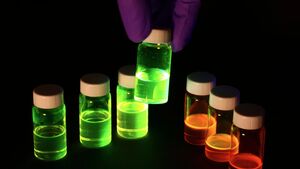
New tool for finding green solvents for printed electronics
"Researchers at Umeå University have developed and published an open web tool for the facile identification of green solvents for sustainable printed electronics. The study is published in Nature Communications. The emerging field of printed electronics promises to radically change the way we view and use electronics through energy- and cost-efficient printing of electronic inks onto everyday surfaces such as paper and textiles. However, a severe problem from a sustainability perspective is that many current inks used during the printing include solvents that are unsafe and damaging for both workers and the environment. In order to address this challenge, Dr. Christian Larsen and Prof. Ludvig Edman together with colleagues at the Department of Physics at Umeå University have developed an open web tool for the facile identification of green solvents for sustainable printed electronics. The green solvent selection tool is openly available through the internet." [...]

Researchers from IRSOL and IAC solve twenty-year-old paradox in solar physics
"In 1998, the journal Nature published a seminal letter concluding that a mysterious signal, which had been recently discovered analysing the polarization of sunlight, implies that the solar chromosphere (a very important layer of the solar atmosphere) is practically unmagnetised, in sharp contradiction with common wisdom. This paradox motivated laboratory experiments and theoretical investigations, which instead of providing a solution, raised new issues and even led some scientists to question the quantum theory of matter-radiation interaction. Today, researchers at the Istituto Ricerche Solari (IRSOL) in Locarno-Monti (affiliated to USI Università della Svizzera italiana), and the Instituto de Astrofísica de Canarias (IAC) in Tenerife, have found the solution to such intriguing paradox, opening up a new window for exploring the elusive magnetic fields of the solar chromosphere in the present new era of large-aperture solar telescopes. Their findings are now published in Physical Review Letters, the prestigious scientific journal of the American Physical Society. Twenty-five years ago, an enigmatic signal was discovered while analysing the polarization of sunlight with a new instrument, the Zurich Imaging Polarimeter (ZIMPOL), developed at ETH Zurich and later installed at IRSOL. This mysterious linear polarization signal, produced by scattering processes, appears at the wavelength of a neutral sodium line (the so-called D1 line) where, according to quantum mechanics, no such scattering polarization should be present." [...]

Groundbreaking visualization of atomic movements
"Novel method for imaging vibrations and movements of atoms in catalysts is developed by a collaboration of internationally leading researchers. A group of leading electron microscopy and catalysis researchers have in recent years been working to determine the three-dimensional arrangements of atoms in nanoparticle catalysts in chemical processes. Their work has combined experimental measurements with mathematical modelling. The result is a new method which makes it possible to identify and locate the individual atoms in the nanoparticle, even if they are vibrating and moving. Until now, atoms in nanoparticles have been expected to be static during observations. But the researchers’ analyses of 3D atomic-scale images demonstrated that the original expectation is not sufficient." [...]

A Robotic Fish Tail and an Elegant Math Ratio Could Inform the Design of Next-Generation Underwater Drones
"Underwater vehicles are typically designed for one cruise speed, and they’re often inefficient at other speeds. The technology is rudimentary compared to the way fish swim well, fast or slow. What if you want your underwater vehicle to travel fast through miles of ocean, then slow down to map a narrow coral reef, or speed to the site of an oil spill then throttle back to take careful measurements? DAN QUINN, an assistant professor at the University of Virginia School of Engineering and Applied Science, and his colleague, recent UVA Ph.D. graduate and postdoctoral researcher Qiang Zhong, discovered a key strategy for enabling these kinds of multispeed missions. They have demonstrated a simple way to implement this strategy in robots, which could ultimately inform underwater vehicle design. Their work was recently published in Science Robotics." [...]
Documentação
A documentação é parte essencial do processo de aprendizagem e a Internet além de artigos interessantes de explorar também tem alguma documentação em formato PDF interessante de ler. Todos os links aqui apresentados são para conteúdo disponibilizado livremente pelo editor do livro.

Learning Go
"Go is a statically typed, compiled programming language designed at Google. It is an unofficial and free Go book created for educational purposes. All the content is extracted from Stack Overflow Documentation, which is written by many hardworking individuals at Stack Overflow. " [...]
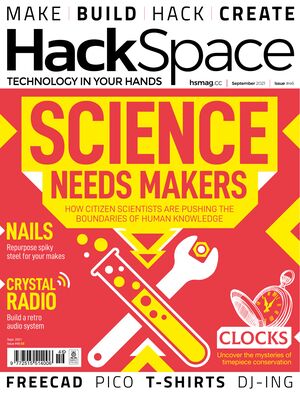
HackSpace magazine #46
"Anyone can be a scientist, and this issue we’ll show you how. Whether you’re interested in space, traffic, the oceans, or something else, there’s a citizen science project for you. The world has never been more connected – so let’s use that connectivity to make our planet better! - We talk to a real-like scientist about the emotional links between making and materials - Turn empty drinks cans and a bit of 3D printing into a heat-exchange system for a laser cutter - Coax random numbers from a humble ESP32 board - Make music with a Raspberry Pi Pico - Build a glorious piece of retro tech in the shape of a crystal radio" [...]
Projetos Maker
Diversos Projetos interessantes.
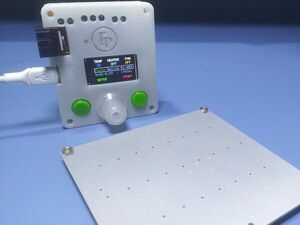
Reflow PCB Hotplate
"A PID controlled DIY reflow hotplate using an Aluminium PCB to solder SMD components Story : Last time I made a reflow soldering hotplate from a regular clothing iron. And it works pretty great. The only issue is it uses mains AC voltage which I don't feel super comfortable to work with so I tried low voltage DC approach. The Idea : The idea is simple, when you apply power to both ends of a conductor, it generates heat. So if we make a PCB that has a very lengthy trace and apply voltage to it’s end terminals it should generate enough heat to reflow a PCB. Key things to note here is that different solder paste has different melting point." [...]
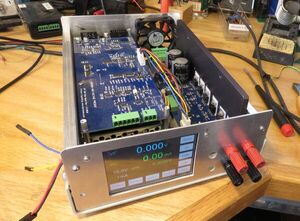
DIY SMU: Source Measure Unit
"As a lifelong analog EE, I have built and used many DC power supplies starting with an LM309 5V regulator in the late 60's. Then on to uA723s, various 3 terminal linears, and many switchers. At Analogic in the late nineties I got to work on Semiconductor ATE equipment. One extreme was the AN/DP8200 VoltBox, a precision 20 bit voltage standard. I was exposed to low power SMUs for semiconductor testing. Then at Teradyne I was an analog EE in their DC instruments group, where we designed serious VIs (voltage-current instrument), DPSs (Device Power Supply) and SMUs for semiconductor and system testing." [...]
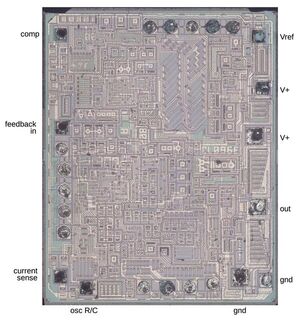
Reverse-engineering a vintage power supply chip from die photos
"I recently did a PC power supply teardown so I figured it would be interesting to go deeper and see what happens inside the power supply's control IC. The die photo below shows the UC3842 chip, which was very popular in older PC power supplies.1 (The chip was introduced in 1984 but this die has a date of 2000.) The tiny silicon die is patterned to create the transistors, resistors and capacitors that make up the circuit. The lighter-colored lines are the metal layer on top of the silicon, forming the chip's wiring. Around the edges, square pads provide the connections from the die to the IC's external pins; tiny bond wires connect the pads to the chip's external pins. " [...]
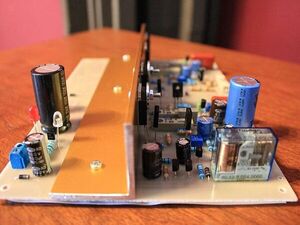
DIY Solar Charge Controller
"Make your own adjustable voltage solar charger. A solar charger is a charger that employs solar energy to supply electricity to devices or batteries. Solar chargers can charge lead acid or Ni-Cd battery banks up to 48 V and hundreds of ampere-hours (up to 4000 Ah) capacity. Such types of solar charger setups generally use an intelligent charge controller. A simple solar charger must have 3 basic features built-in: - It should be low cost. - Layman friendly, and easy to build." [...]
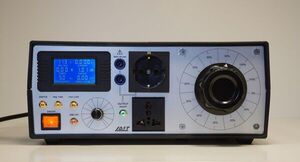
DIY Variable Isolation Transformer
"Let’s clear one thing first. This is not a “Step by step -How to” guide to make your own variable isolation transformer. This is just me sharing my work, comments and ideas while building a piece of much needed equipment for my bench. Maybe it gives you a little push or sparks an idea for doing something similar. Whether you are diagnosing a broken piece of electrical equipment or testing a repaired one, there comes a moment when you have to plug it into mains. That moment is like playing a lottery." [...]

Battery Soldering Iron
"Finally I've made a working battery based portable soldering iron. This one can melt solder in under 10 seconds, which is amazing. The soldering iron weighs just above 100 grams, is comfortable to use, it can reach more than 300 degrees, it's very fast, we can recharge it with a USB connector since we have a protection IC inside on the PCB and on the screen, we can see the battery level, the internal resistance of the iron tip and we can set the heating time and maximum power. On the PCB we have a current sensor so we can measure the current and with that the power, we have an amplifier to measure the low resistance of the tip, and we have a MOSFET to control the power that is going to the tip. So for the components we need, of course the PCB which in my case, I’ve made it with PCBWAY. The MOSFET, the ATmega328 microcontroller together with the crystal oscillator, the SMD resistors and capacitors which are all in a 0603 package, the small SMD buzzer, some LEDs, the USB connector, the LM358 amplifier, the small OLED screen and the AMS712 current sensor." [...]
Arduino based Sun Tracking Solar Panel
"How to Make Solar Tracker System using Arduino and LDR | Arduino based Sun Tracking Solar Panel" [...]
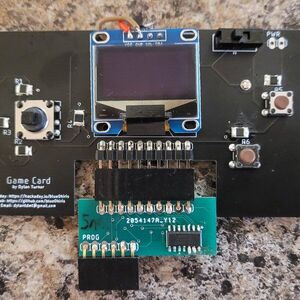
Game Card
"A $15 game console the size of a business card that plays multiple games via cartridges. The Game-Card is game console with the dimensions of a typical business card (3.5x2"). Unlike most small Arduino game consoles, the Game Card ALSO plays multiple games without having to re-flash the system, i.e. it's actually a console, unlike the others which are really just one game. It has two parts: the card itself and the cartridge. The console is simply a shell." [...]
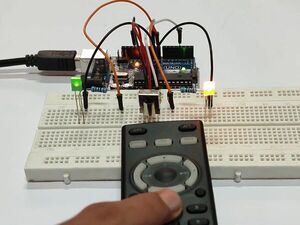
Remote Controlled LEDs with IR Receiver and Arduino
"Control two LEDs with IR Remote, IR Receiver and Arduino. This project shows how to control two LEDs with IR Receiver and Arduino. An Infrared (IR) transmitter uses light to transmit signals to the IR receiver. The light is in the form of invisible infrared pulses and corresponds to specific codes. Each code corresponds to a particular command. The receiver decodes the corresponding pulses to the specific code and executes the commands." [...]
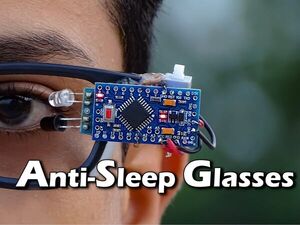
Anti-Sleep Glasses
"Sleeping on wheels is dangerous sometimes it may converts into fettle accidents. these glasses will alert you when you feeling drowsiness. Hello all, I Hope you all are safe. I'm here with another project which you can build with very few components. In this instructables, I'm going to show you, how you can make an Anti Sleep Glasses by using Arduino and some very basic electronic components. This glasses alerts the driver whenever he is getting into sleep while driving the vehicle." [...]

How to Build a Pico Macro Pad
"In this instructable, I am going to show you How to Build a Macro Pad using Raspberry pi pico Pico KeyPad is a must-have shortcut keyboard for your PC work. This keypad consists of 9 keys (you can add more no. of keys), the size of this 3x3 keypad is small and can be easily carried out. All this 9 keys can be programmed for any shortcut. You can use it during programming / Coding or during editing and more, all the software shortcuts are compatible with this keypad. In this written tutorial we a going to see how can we make it." [...]
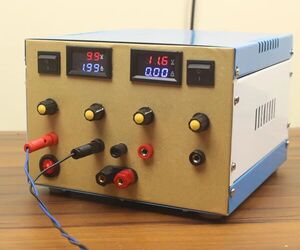
DIY Dual Channel Variable Lab Bench Power Supply 30V 10A 300W
"A bench Power supply is a very important piece of equipment that every electronics hobbyist can own. It helps to limit the voltage and current. That is mandatory when were testing circuits, charging batteries, and testing components, as well as gadgets but the problem, is these power supplies arent so cheap and a beginner doesnt want to invest such a lot of money in a piece of equipment. Here, we will design a bench power supply that is very cost-effective and fully modular so everyone can DIY it with some basic knowledge about electronics. There are quite a few components you will need. The most important one we need, a module that can control all the voltages and current limiting stuff." [...]

Anti-Theft Tool Using Raspberry Pi Pico
"This project is a prototype of a smart home system using raspberry pi pico. Evil can stalk anyone, and wherever we are. Even in the home, crime can happen. Even if the house is locked at night, and given CCTV, it will not be able to guarantee everything is safe. Therefore, there is a need for a danger alarm to notify the homeowner if the house or room is entered by strangers or thieves. And he made this warning alarm to anticipate the danger of thieves or strangers who will enter the house or room." [...]
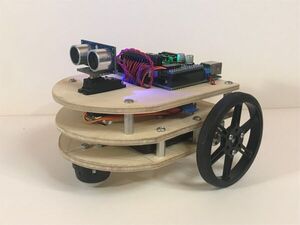
Pet on a Chip
"A few years back in high school I worked on building the robot described in the 1979 book “How to Build Your Own Working Robot Pet” by Frank DaCosta. The robot was controlled by an 8085 (an 8-bit microprocessor), and required a ton of 74xx series logic chips to interface to the various control and sensor systems on the robot. For my senior design project in college, I wanted to create a new robot where all of the control logic would be integrated onto a single chip, and so Pet on a Chip was born. This new robot improved upon the original by drastically reducing power consumption, size, weight, and improving maneuverability, and all of the control logic was implemented on an FPGA. This project built off of my TinySoC project I had worked on during the summer. The robot’s FPGA contains the following modules: - A custom 8-bit CPU with on-chip memory - A simple text mode VGA graphics controller - Twin closed loop motor speed controllers - A servo controller - An interface to a sonar module - A UART - Counter/Timers - GPIO" [...]

IOT Capstone Project
"This project is an example of the applications of the Internet of Things in temperature sensing based industries. This project is based on the applications of the internet of things (IOT). I have used Bolt WiFi module to connect and send data to the Bolt cloud. This WiFi module is connected to the temperature sensor and a power supplying device. This setup will sense the surrounding temperature, detect anomalies, predict data and send an alert (e-mail) to the user by using mailgun's services whenever an anomaly is detected. This will help the user to monitor any temperature based machine continuously and detect and predict any anomaly." [...]
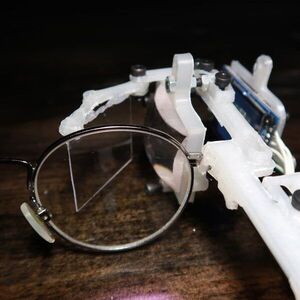
Raspberry Pi Zero W Smart Glasses
"It's a display in front of your eyes that runs Linux. You can do pretty much anything with it. This is a project that I've been working on and it's a pair of Raspberry Pi Zero W -based Smart Glasses. It has a single 240x240 IPS display [ST7789VW] that runs at 60 hz, a camera for doing hand tracking etc. (optional) and a 3d-printed frame to hold it together. I was annoyed by the shear amount of Arduino smart glass clones on the internet and I needed a bit more powerful (and affordable) smart glasses so I created this project." [...]

ESP8266 Weather Widget V2.0
"Welcome to my new Weather Widget Project. Earlier I have posted an Instructables on the weather widget, that uses a 0.96" OLED display to display the weather parameters. The main problem in the earlier version is that the display is very small in size, so you have to come very close to it for reading the parameters. That's why it was always in my mind to upgrade it to a larger color display with a nice 3D printed enclosure. Recently I was browsing Banggood website for purchasing few components for my upcoming project, then I came across a desktop Weather Station. I showed the product to my wife and she was fascinated with it and wished to see it on her craft table." [...]
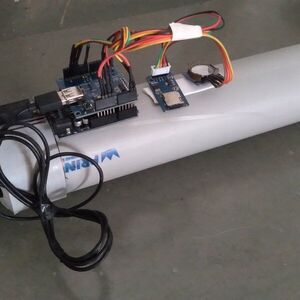
Low-cost seismograph using optical mouse
"Hack an optical mouse to detect seismic vibrations with a simple laser source, a hacked mouse lens and a physical cantilever arm setup. The "seis-mouse-meter" was part of the 2020 Frugal Science course (frugalscience.org), where we were challenged with solving crowd sourced global problems with frugal solutions. Our chosen problem was to detect and warn of crop raiding elephants in rural India. Our hack was to use an optical mouse's image sensor and high speed surface features detection hardware to sense minute vibrations created in the ground when these heavy animals walk or rumble or talk to each other. " [...]

The Monkey Island (TM) PC-Speaker music player
"- I modified DOSBox to extract the frequency/delay value pairs of the Monkey Island PC-Speaker songs. - I then used Huffman compression to squeeze all music inside an ATtiny85 (512 bytes of RAM, 8 KB of flash) - Once I managed that, I then created a small circuit with a speaker - to play the music... - ...as a gift for my nieces and nephews; whom I'll see next week after more than a year's isolation (COVID)! " [...]

Make a LED Matrix Box With Multiple Effects
"The use of LED Matrix Max7219 is quite common nowadays. You can use it for many different applications such as: Clocks, Scrolling Text, advertising... However, the sample code related to Max7219 I found relatively difficult for newbies, so I tried to rewrite the code as concise, understandable and clean as possible! *** List parts *** - Arduino Nano: - Max7219: - Wires: - 3D Box *STL files:" [...]
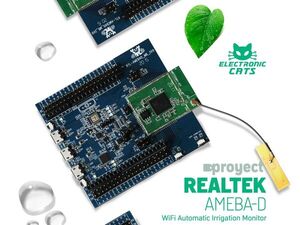
AmebaD and Arduino humidity monitor for house plants
"Your plants die when you are on the road, this practice will help you create a Wifi monitor to keep an eye on them. In this practice a solenoid valve is controlled while the temperature and humidity of a plant are sensed to have an irrigation control, originally it was thought to use an I2C sensor (DHT20), due to problems with this protocol on the board it was decided to use an analog temperature sensor (TMP36). " [...]
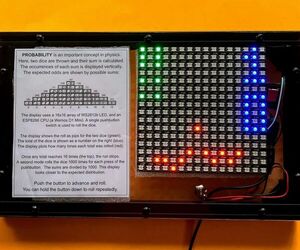
Two Dice Roll Demonstration for Physics and Probability
"Probability is an important concept in Physics since many physical interactions can have multiple outcomes. This project is a hands-on exhibit to allow students to see the results of dice rolls to get a better intuitive feel for probability and the difference between single events and many events averaged together. One description can be found at this site at Georgia State University: http://hyperphysics.phy-astr.gsu.edu/hbase/Math/d... This project uses a 16x16 array of WS2812b LEDs ("Neopixels") and an ESP8266 CPU (a Wemos D1 Mini). A single pushbutton switch is used to roll the dice. The display shows the dice roll as dice pips for the two dice." [...]

3D Printed Racing Quadcopter
"Lets make a 3D printed quadcopter frame! This frame is different compared to conventional frames wherein its more of a Cross or X, This frame is more of a Semi H/X. Compared to other frames this design will give you a lot of space especially for your FPV equipment, Gimbal, and more. Its Faster than your normal X configuration quad, just pack it with some of your favorite motors,ESC', Batteries and receivers and your ready to go This build will be concentrating on the frame build and electronics parts only for the tuning its up to you or your local hobbyist to help you out in tuning. (LOOK at the last step for the best way to get your quad running without doing manual tuning) Design: The design is based from the 250 Blackout mini Quad, I was inspired in our local flying which lead me to making this using my old F450 parts. The 250 Blackout frame is famous among mini Racers since its designed to crash and its length gives it the upper hand to pitch forward with ease and speed 250 size Mini Quad Race video" [...]
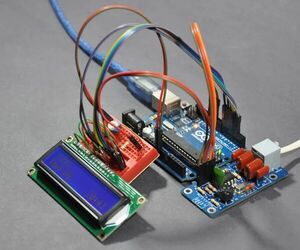
Arduino Telephone Caller ID Unit
"CLI, also known as Caller ID and calling number delivery (CND), is a service offered by the telephone service provider to customers to obtain the calling party number and date/time of the call. The service activation and information format of CLI are different from telephone network operator to operator. In this project, we will create a simple Caller ID decoder using Arduino UNO and a custom-made HT9032D module. The core component of the project is the HT9032D, which can decode incoming call ID data over a telephone connection. This IC supports Bell 202 FSK and ITU-T version 2.3 CLI protocol specifications. This caller ID display unit consists of 2 line character LCD to display caller ID and date/time information sent by the telephone exchange." [...]
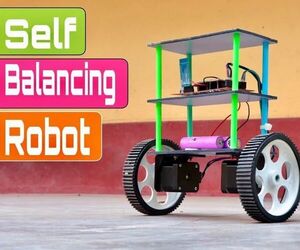
How to Make DIY Smartphones Controlled Self Balancing Robot
"In this instructable, i'll show you How to Make DIY Smartphones Controlled Self Balancing Robot. It's very interesting project for any electronics hobbyist & Engineers. Self-balancing Robot is very interesting. Many friends around us were trying to make one, but they encounted a lot of chanllenges including the lack of the easy-to- assembly structures, the suitable electronic circuits and the programs. So I decided to make a self-balancing robot as simple as possible. I want the assembly of self-balancing robot to be very easy." [...]

Internet Weather Station
"The ESP12-E based nodeMCU fetches weather data set from the internet, process them, and display it on a Graphical LCD based on ST7920. When it comes to making a weather reporting device, sensors are the first to come to mind. There are lots of such weather projects available that use a separate sensor for each weather parameter. You need temperature and humidity sensors for measuring ambient temperature and humidity in the air around us, pressure for measuring atmospheric pressure. It is fine if you need to see two, three-parameter, but what about measuring near a dozen of weather parameters like wind speed, wind gust, visibility, and much more. That would not only increase the cost per sensor but would also make the project messy hooking these numbers of sensors and bulky in the form factor." [...]
Secção Videos
Videos interessantes.
That's all Folks!






